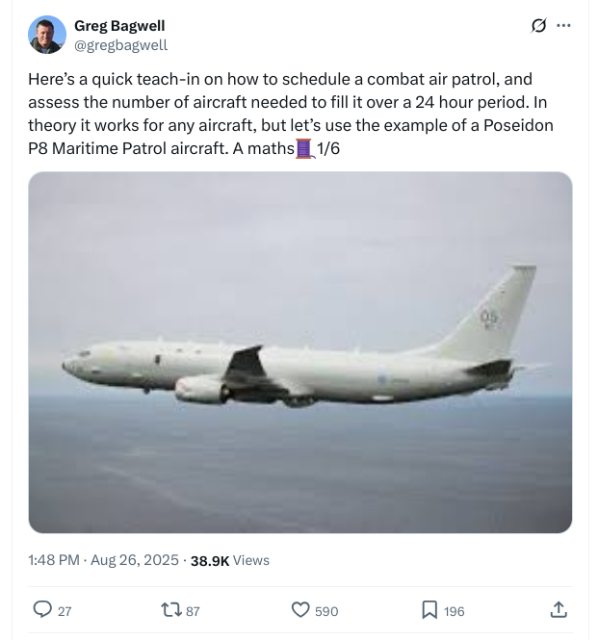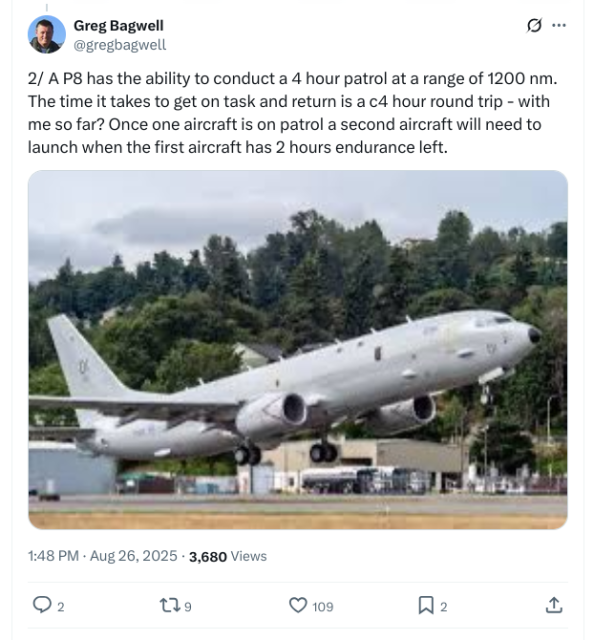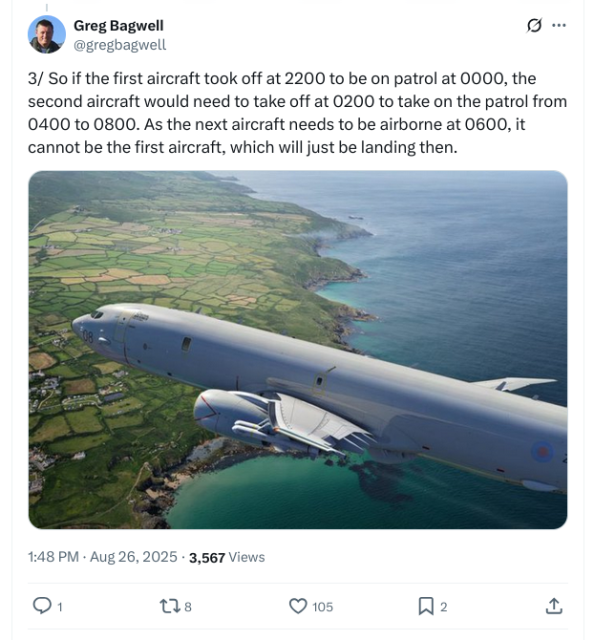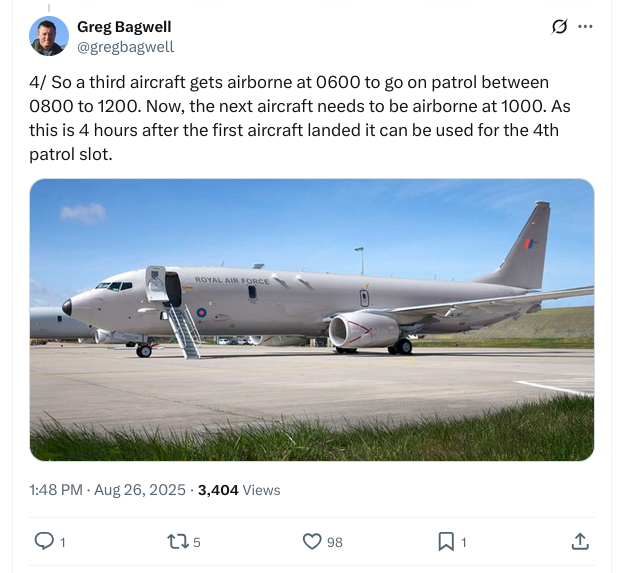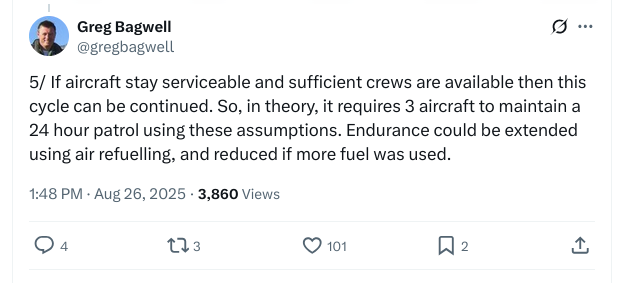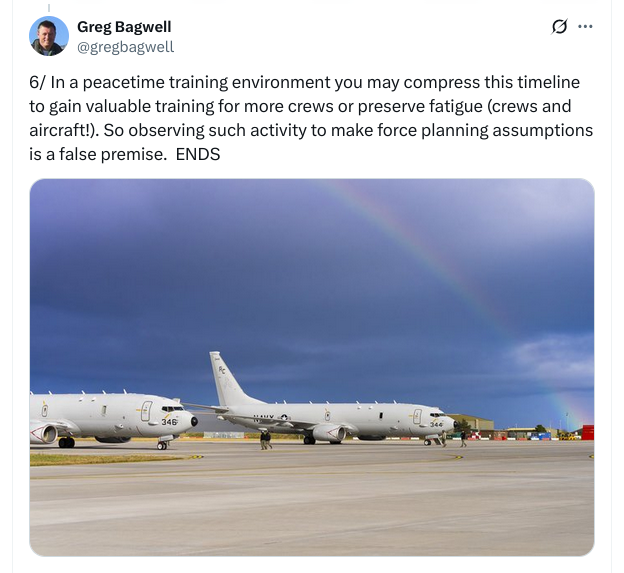I was captivated by Greg Bagwell’s thread on X/Twitter recently and I can not aid intending to share it with you.
Greg Bagwell CB CBE is a retired senior Royal Flying force commander that offered 36 years, finishing his job as Deputy Commander (Workflow) at RAF Air Command– the service’s most elderly functional function. He regulated significant operations and has more than 4, 000 flying hours, largely on Tornado aircraft.
His thread breaks down something that appears stealthily easy however gets complex quick: the math of preserving 24 -hour air patrol coverage.
Right here’s a fast teach-in on just how to set up a combat air patrol, and assess the number of aircraft needed to load it over a 24 hour duration. In theory it helps any kind of airplane, yet let’s use the example of a Poseidon P 8 Maritime Patrol aircraft.
His example is the Boeing P 8 Poseidon, a contemporary maritime patrol and reconnaissance aircraft created for the US Navy and allied forces, currently in procedure in the United States, UK, Australia, New Zealand, Norway, South Korea, Germany and Canada. The airframe is a strengthened Boeing 737 – 800 with a tools bay, sonobuoy deployment system for anti-submarine war and devoted army avionics. The P 8 commonly operates with a team of nine: two trip team and 7 goal professionals. It has an optimal rate of 490 knots (564 mph or 955 km/h) with a ceiling of 41, 000 feet (12, 500 m). It has a fight span of 1, 200 maritime miles (1, 383 miles or 2, 225 kilometres) with four continuous hours conducting its objective at the marked target location prior to requiring to return the up-to- 1, 200 -nautical-mile distance to get home once more.
A P 8 has the ability to conduct a 4 hour patrol at a series of 1200 nm. The time it requires to hop on task and return is a [circa] 4 hour round trip– with me so far? Once one aircraft gets on patrol a second airplane will need to release when the very first airplane has 2 hours endurance left.
Admission: I’m somewhat perplexed by his use endurance below however what’s clear from his instance is that the P 8 has 8 hours gas endurance (can fly securely for eight hours).
The patrol objective is 2 hours flying out, four hours over the target location and after that 2 hours flying back.
When the initial P 8 has 2 hours of patrol left, the 2nd P 8 have to leave for its trip to the target location, that way it comes to the target area just as the initial P 8 is leaving. Or else, they don’t have continuous coverage, right?
The next tweet validates that this is what Bagwell meant: the second aircraft needs to introduce when the very first aircraft has 2 hours of patrol left.
So if the very first airplane took off at 2200 to be on patrol at 0000, the second aircraft would require to remove at 0200 to take on the patrol from 0400 to 0800 As the next aircraft requires to be airborne at 0600, it can not be the first airplane, which will simply be landing after that.
This makes good sense. The very first airplane stops patrolling to go back to base at 04: 00 as the 2nd airplane takes over. It will certainly get here back at 06: 00, which is the same time as the following airplane requires to leave, so we need 3 airplane.
So a 3rd aircraft obtains air-borne at 0600 to go on patrol in between 0800 to 1200 Now, the next aircraft requires to be airborne at 1000 As this is 4 hours after the first airplane landed it can be made use of for the 4 th patrol slot.
So far, so great.
If airplane remain serviceable and sufficient teams are offered then this cycle can be proceeded. So, theoretically, it calls for 3 aircraft to maintain a 24 hour patrol utilizing these presumptions. Stamina could be extended utilizing air refuelling, and reduced if more gas was utilized.
OK, I have actually practically handled this but I’m not sure I’m ready to handle air refuelling! Fortunately, the mathematics lesson seems to be over.
In a peacetime training atmosphere you might compress this timeline to gain useful training for even more crews or maintain tiredness (teams and aircraft!). So observing such activity to make force planning presumptions is an incorrect facility.
I was just questioning crew tiredness: that’s an eight-hour flying day. The initial P 8 returns home as the third one is leaving … yet it needs to reverse and fly out to soothe the 3rd patrol in just four hours, so undoubtedly that have to need a brand-new staff.
As a matter of fact, the first talk about the string inquires about exactly this.
Many inquiries. Just how does utility decrease in time? Just how much rest do staffs need in between sorties and does this increase over time? The number of days then can an onward fleet of 6 – 7 airplane efficiently keep this price for? Exactly how does AAR impact remainder and service?
Greg Bagwell:
A staff doing an 8 hour goal, would certainly expect at the very least 8 hours of rest (I bear in mind 10 hours break with at the very least 8 available for rest), yet in peacetime you would only want to do one of those a day. There would be a restriction on hours per month so refuelling only uses that up faster.
These are more for peacetime, you would certainly take far greater risk in war time.
Some grabs can be brought depending on threat appetite/need. The airframe/engines should be fairly robust, so specialist tools will be the ones to watch.
And later in the thread, Bagwell validates that at least 6 teams are required along with an additional aircraft to deal with upkeep problems.
Is it a good idea or even viable to have a fourth airplane readily available in case among the first three has some sort of casualty needing repair service that takes longer than the tempo prepares for?
Greg Bagwell:
Definitely.
So what’s the number of teams required to do this?
Greg Bagwell:
Sustained? Probably 6 So it’s not an airframe numbers problem.
The factor is that the P 8 s are, in his example, not the limiting element, but instead, the variety of trained staffs to run them.
Thanks to Greg Bagwell for laying it out so plainly. The male is a nationwide prize!
